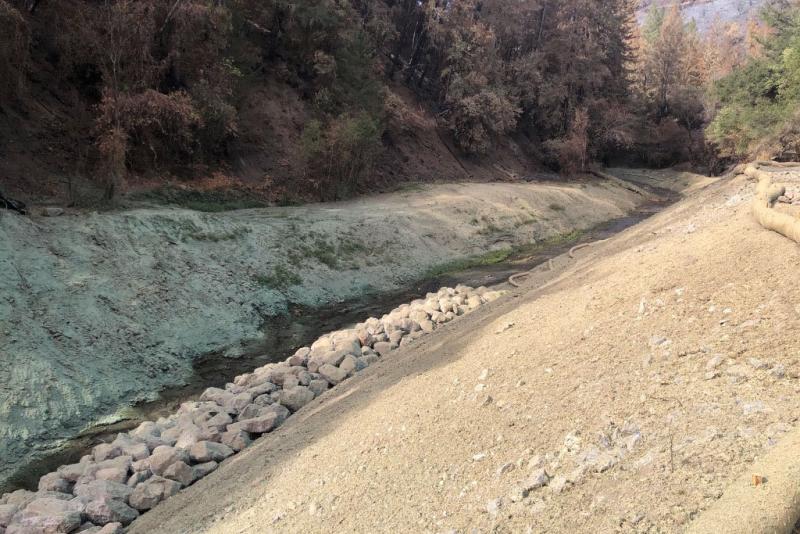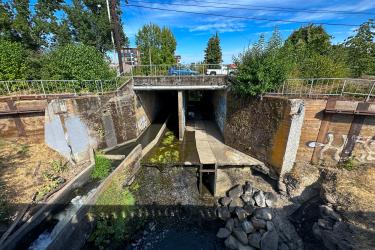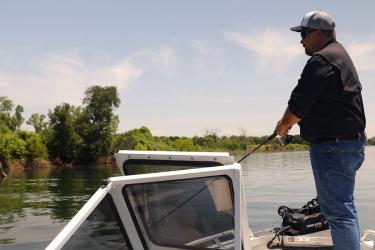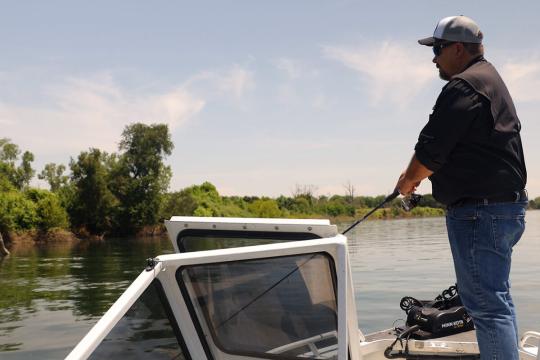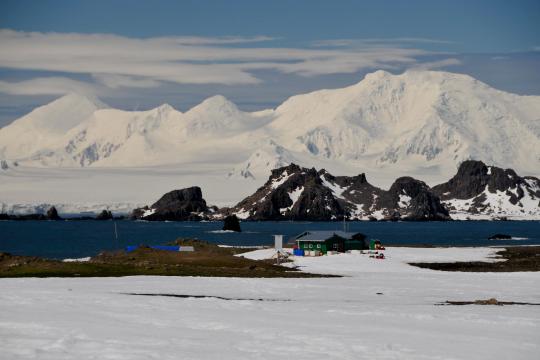Most dam removal projects view sediment as a problem. Biologists often worry that releasing the stored sediment will harm fish and wildlife or disperse in unpredictable ways to change the course of streams. Others see releasing stored sediment as a catalyst for flooding. In some cases, though, sediment can be a solution.
Biologists working to remove the dam on York Creek knew that sediment spreading naturally through the York Creek and Napa River watersheds could benefit the ecoystem. It could replenish gravel and restore spawning beds, rearing habitat, and resting habitat for steelhead listed under the Endangered Species Act.
“Sediment is the foundation of all habitat,” said Brian Cluer, a geomorphologist in NOAA Fisheries’ West Coast Region. “It shapes the environment.”
Because York Creek Dam captured most sediment, the flowing water cut deep into the bed of the creek downstream and became disconnected from its adjacent floodplains. Allowing transport of sediment downstream would reverse that process and help water to again reach side channels and the floodplain. These habitats provide critical refuge for juvenile steelhead and other aquatic life during times of high streamflow.
Stillwater Sciences, a consulting firm, modeled erosion of the sediment impounded in the reservoir. They found that if the dam were removed, sediment was likely to pass through the creek system quickly, with a low risk of flooding. Biologists also drew on lessons from a previous dam removal on the Carmel River. Crews had built engineered step-pools and positioned large wood structures to provide habitat for steelhead. Unfortunately, unusually high flows in the Carmel River shortly after construction upset the engineered features and reduced the benefits to fish.
“A much more elegant plan in this case was to not build an engineered channel, but rather to let the stream work with the sediment to solve the reservoir deposit problem for us,” Cluer said. While the City of St. Helena decided to remove a modest amount of sediment to reduce the potential for flooding downstream areas, they agreed to allow the rest of the impounded sediment and future naturally derived sediment to pass downstream. “Sediment doesn’t have to be a problem. It can be the solution you’re looking for.”
Partners in the York Creek dam removal used the retained sediment to their advantage. Instead of trying to engineer a new stream, they gave the creek the freedom to restore its own natural features. They placed 36 log structures in the channel downstream from the dam to create conditions that would affect sediment transport.
In some areas, the log structures will slow the water so that sediment settles into strategic locations. In other areas, the log structures should help increase the speed of the water, scouring the bottom. As the sediment collects in downstream areas, it will help raise the elevation of the streambed. This will increase the size of pools and gravel bars and reconnect the stream with side channels and seasonal wetlands. All of these changes help improve steelhead habitat. Of course, removing the impassable dam itself also allows steelhead into high-quality upstream habitat they have not reached since 1900.
Once the project design was finalized by the EKI, Inc./WRA, Inc. team selected by the city to complete final engineering and permitting, the biggest challenge became time. Construction started in June 2020 and needed to wrap up by the end of October to avoid impacts on other species and to meet grant restrictions.
Could They Make It?
In order to make the timeline, the NOAA Fisheries team had “met with everyone multiple times on a regular basis to make sure everyone understood what we were doing,” Cluer said. “This project required an ecosystem solution instead of building a big new structure to manage everything.”
The trust and understanding that grew from those early meetings gave agencies the confidence to solicit bids in May, even before their permits were issued. By June, the construction contractor, McCullough Construction, Inc., was selected and received permission to proceed. Says Jenn Hyman, the project manager for EKI, “We are grateful to the agencies for the time and effort they put into all the meetings and coordination to allow us to get the project designed, permitted, and underway in record time.”
Given the COVID-19 pandemic, the work proceeded with hand washing stations, face masks, and a socially distanced kickoff meeting among the City, WRA and the construction contractor. In July, crews began removing some sediment from the one-time reservoir. The pandemic also reduced traffic near the construction site and in downtown St. Helena, making construction hauling more efficient.
The stream would likely redistribute remaining sediment and improve the streambed with the first winter storm, further improving with each successive storm, Cluer said. Most of it would find its way downstream as far as the Napa River. The Napa County Resource Conservation District also developed a 10-year monitoring plan to track the sediment through the system. This will help determine whether the natural processes proceed as anticipated.
Construction mostly wrapped up by September, a month ahead of schedule.
Wildfire Burns Through
In the early morning of September 28, 2020, a few days after construction ended, the Glass Fire swept through the project site. The fire that destroyed hundreds of homes also toppled trees, and replaced the lush forest understory with a moonscape of ash and rocks. It also damaged the large log structures placed in the stream, charring them and consuming most of the smaller wood pieces.
Partners in the dam removal remain confident that the stream will complete most of the restoration itself. A Watershed Emergency Response Team will inspect the creek and upland areas and map locations susceptible to landslides, rock falls, and flooding risks. They will recommend any necessary steps to reduce impacts of ash or other results of the fire.
The new landscape emerging from the last vestiges of the reservoir offers new opportunities for threatened Central California Coast steelhead. Access to the additional habitat will make the fish more resilient to wildfire, for instance.
“The project reflects a model of cooperation and collaboration based on the best science,” said NOAA Fisheries West Coast Region biologist, Dan Logan. “We took the time to make sure we were all speaking the same language, and we all had a stake in the success of the project,” he said. “Instead of worrying about the pitfalls, we focused on the opportunities to improve the creek in ways that benefit the broader ecosystem.”
The York Creek Dam Removal project demonstrates how federal, state, and local jurisdictions can find solutions that benefit everyone. Thank you to all our partners and stakeholders for the hard work and determination in advancing the recovery of threatened steelhead:
- City of St. Helena
- Consultants with EKI Environment & Water, Inc., and WRA
- California Department of Fish and Wildlife
- Spring Mountain Vineyard
- Napa County Resource Conservation District
- Regional Water Quality Control Board
- U.S. Fish and Wildlife Service
- U.S. Army Corps of Engineers
